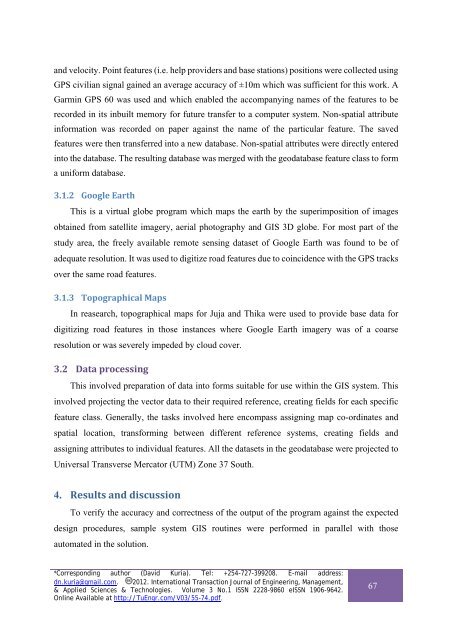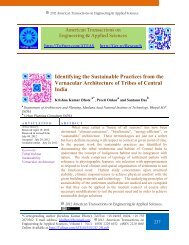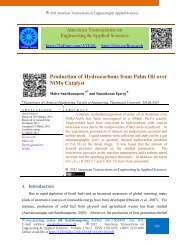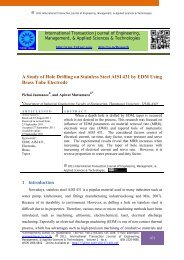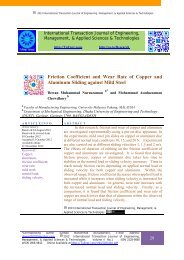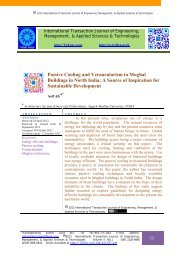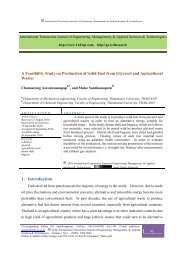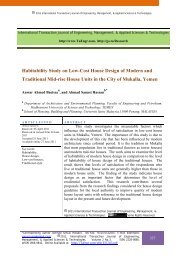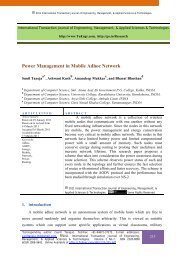Setting up of a Kenya National Domestic Violence Call Center (K ...
Setting up of a Kenya National Domestic Violence Call Center (K ...
Setting up of a Kenya National Domestic Violence Call Center (K ...
Create successful ePaper yourself
Turn your PDF publications into a flip-book with our unique Google optimized e-Paper software.
and velocity. Point features (i.e. help providers and base stations) positions were collected using<br />
GPS civilian signal gained an average accuracy <strong>of</strong> ±10m which was sufficient for this work. A<br />
Garmin GPS 60 was used and which enabled the accompanying names <strong>of</strong> the features to be<br />
recorded in its inbuilt memory for future transfer to a computer system. Non-spatial attribute<br />
information was recorded on paper against the name <strong>of</strong> the particular feature. The saved<br />
features were then transferred into a new database. Non-spatial attributes were directly entered<br />
into the database. The resulting database was merged with the geodatabase feature class to form<br />
a uniform database.<br />
3.1.2 Google Earth<br />
This is a virtual globe program which maps the earth by the s<strong>up</strong>erimposition <strong>of</strong> images<br />
obtained from satellite imagery, aerial photography and GIS 3D globe. For most part <strong>of</strong> the<br />
study area, the freely available remote sensing dataset <strong>of</strong> Google Earth was found to be <strong>of</strong><br />
adequate resolution. It was used to digitize road features due to coincidence with the GPS tracks<br />
over the same road features.<br />
3.1.3 Topographical Maps<br />
In reasearch, topographical maps for Juja and Thika were used to provide base data for<br />
digitizing road features in those instances where Google Earth imagery was <strong>of</strong> a coarse<br />
resolution or was severely impeded by cloud cover.<br />
3.2 Data processing<br />
This involved preparation <strong>of</strong> data into forms suitable for use within the GIS system. This<br />
involved projecting the vector data to their required reference, creating fields for each specific<br />
feature class. Generally, the tasks involved here encompass assigning map co-ordinates and<br />
spatial location, transforming between different reference systems, creating fields and<br />
assigning attributes to individual features. All the datasets in the geodatabase were projected to<br />
Universal Transverse Mercator (UTM) Zone 37 South.<br />
4. Results and discussion<br />
To verify the accuracy and correctness <strong>of</strong> the output <strong>of</strong> the program against the expected<br />
design procedures, sample system GIS routines were performed in parallel with those<br />
automated in the solution.<br />
*Corresponding author (David Kuria). Tel: +254-727-399208. E-mail address:<br />
dn.kuria@gmail.com. 2012. International Transaction Journal <strong>of</strong> Engineering, Management,<br />
& Applied Sciences & Technologies. Volume 3 No.1 ISSN 2228-9860 eISSN 1906-9642.<br />
Online Available at http://TuEngr.com/V03/55-74.pdf.<br />
67


